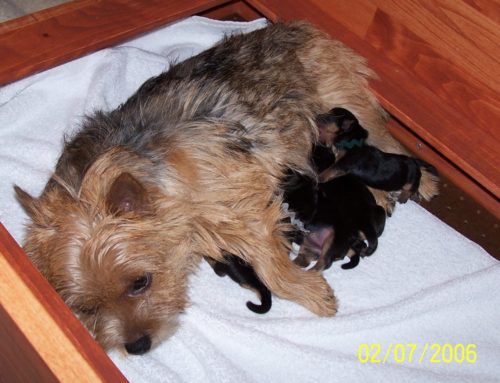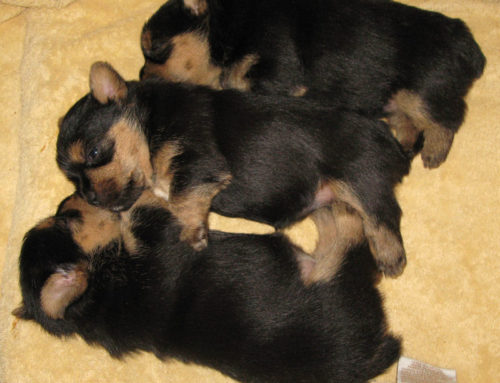I’ve been tube feeding a Norwich Terrier puppy every 3 hours, for 4 days. The puppy rallied yesterday, gaining nearly an ounce (my hopes soared), but she faded away this morning before daybreak. Feeling defeated and flipping through an old issue of The Norwich & Norfolk News for inspiration to write this column, I found this rather timely passage written by renowned breeder Constance Larrabee (King’s Prevention) in 1986: “I often wonder why we stay in it, but if there is anything that makes me think I am a survivor it is having had the good times and the bad times raising puppies.”
We know that neonatal puppy deaths are common, with published mortality rates of 15% to 30%. The immaturity of newborn puppies makes them extremely vulnerable. Respiratory distress after dystocia and bacterial infection are common causes of neonatal death. Other predisposing factors include congenital malformations and genetic defects, low birth weight, and environmental conditions. The perinatal death rate is highest during whelping, immediately after birth, and in the first days of life. But, death can (and does) occur in the subsequent weeks of life, even after weaning. These late deaths are the most distressing. My puppy was 13 days old.
Norwich puppies seem to be more fragile than many other breeds in the first weeks of life. Has it always been this way? In their early days, Norwich were sturdy little rough coated hunt terriers and the early breeders bred first for soundness, temperament and small size — not for the show ring. Constance Larrabee started showing her Norwich in the early 60’s, although she had them for a decade prior. “We should breed sturdy dogs and not just pretty dogs.” Her writings in the 1980’s hint at problems: “In my opinion, and it is just my opinion, our breeds would die if it weren’t for people and I don’t believe we should be breeding dogs that have difficulty whelping.”
Johan Ostrow (Windyhill) wrote that her litters were always problem-free after whelping, but by 1970, when she started in the breed, there appeared to be difficulties with the actual whelping and puppies getting stuck in the birth canal. “I found it was hard to get information from others on this subject. It does the breeds no good if we do not share our experiences be they good or bad.” Many of our Norwich bitches have difficulty whelping today, but breeders are often reticent about sharing bad experiences (whether whelping or other health problems). Like many newcomers, I set out to develop a line of free-whelping Norwich. Nearly two decades later, I’ve only had one bitch who free-whelped her puppies easily — that is, hands off. Others either needed help with stuck puppies or just never progressed to having productive contractions and required a c-section. Getting Norwich puppies on the ground is sometimes hard; keeping them alive can be harder.
Every death is heartbreaking, and in Norwich the heartbreak is magnified by our small litter size (3-4 pups on average). We do all we can to make them live! I weigh mine twice a day, hover over the whelping box with tube-feeding and hydration supplies and assorted medications close at hand. Fading puppy syndrome is not a diagnosis and not a satisfactory explanation. Some of us are trying fresh serum transfer to boost the immune system, suspecting failure in the passive transfer of antibodies to the neonate. Puppies have immature lungs, another risk and possible contributing factor. My puppy’s body will be on this evening’s Fedex truck; she’s the eighth puppy to be examined as part of a new Norwich Terrier puppy lung development disease study at Michigan State University. We hope to understand the pathophysiology and, someday, to cure disease and prevent early death in our Norwich Terriers. While we wait for answers, we plan each breeding with careful study of pedigrees and consider soundness, type, temperament. and genetic diversity.
Why do I keep breeding Norwich Terriers? Because I believe the world is a better place (and I’m a better person) with Norwich Terriers, and the good times really do outnumber the bad times.
Jane R. Schubart, AKC Gazette Breed Columnist ascot.js@gmail.com; The Norwich Terrier Club of America website: www.norwichterrierclub.org (717) 635-8464





